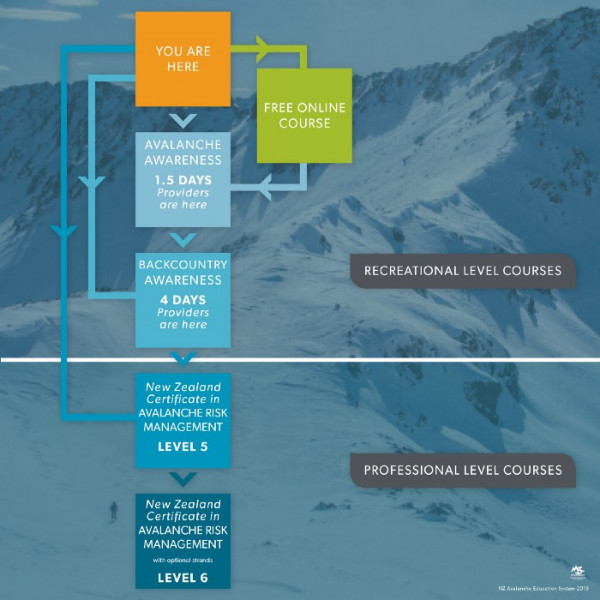Avalanche Safety Series: Training
Can you identify avalanche terrain? Do you understand the avalanche advisory? Do you know how to rescue others in an avalanche? If you said ‘kind of’, ‘maybe’ or ‘no’ to one of these then this three-part series is for you. Share with your snow loving mates.
Before you head into backcountry avalanche terrain (outside any ski field boundary), you need to make sure you have the necessary skills and knowledge so you make it home safely. This article will focus on how you can get the required training.
Did you know that in New Zealand, on average, there are 37 reported avalanche incidents involving people each year?
How do you get trained?
As a beginner, starting your journey of avalanche education can often be a scary and daunting prospect. However, this doesn’t have to be the case! The diagram below outlines the courses you can take to complete both recreational and professional level training. Start with a recreational level course to gain the basic skills and develop a solid base of experience to build on.

Free Online Avalanche training
If you are a beginner, the best place to start is with the NZ Mountain Safety Council's free online avalanche course. This will teach you the basics about what an avalanche is, simple steps you can take to reduce your exposure to avalanches, and the basics of how to rescue your partner if everything goes wrong. Even if you've done a course before, this can serve as a valuable refresher each season!
Recreational Avalanche Courses
Avalanche Skills Course 1 (ASC1) - previously known as Avalanche AwarenessAlthough free online courses and video resources are a great start, nothing beats hands-on practical training with an avalanche professional. As the graph above shows, a 1.5-2 day ASC1 course is the first step. This will put the topics you covered in the online course into practice as you spend the day out on the slopes.
This course covers a range of skills including understanding weather, terrain, snowpack, and how these relate to avalanche conditions. Route selection, safe travel techniques, and how to make evidence-based decisions in avalanche terrain.
Avalanche Skills Course 2 (ASC2) - Previously known as Backcountry Avalanche
The next step is to move onto a more in-depth 4-day ASC2 course. This course focuses more on giving you the tools to better assess the avalanche conditions and make your own decisions based on the evidence you find in the mountains.
This course covers an extended range of skills including identifying when the weather is creating an instability, what snowpack factors lead to stability vs instability, and how to identify and test for them. Of course, small group search and rescue is also included.
You can find a list of course providers here
Professional Avalanche Courses
If you still have an appetite to keep learning and pursuing snow safety as a career then you’ll need to start your professional avalanche courses.
Continue your learning
Remember this is only the first of 3 steps. The Forecast and Equipment you take with you are essential for Avalanche Safety. The forecast and equipment will be covered in detail in the next article.
Watch useful Videos
There are also plenty of videos available to start your learning process. Our EpicTV Avalanche Series is a great place to start.
For more information on avalanche safety: Visit avalanche.net.nz